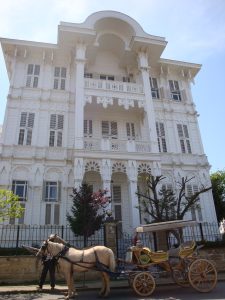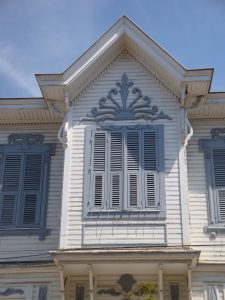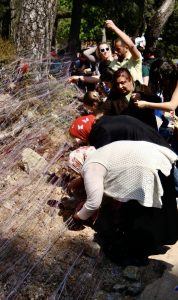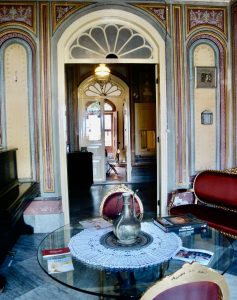“Big Island”
Old name: Prinkipo
Pilgrimage: 23 April (Feast of St George)
Favourite son: Lefter Kücükandonyadis (footballer)

The jewel in the crown of the Princes Islands is Büyükada (Big Island), the last stop on the ferry routes and by far the most magnificent of the islands. It offers a heady mix of attractions including an atmospheric monastery, some spectacular wooden houses, plenty of fish restaurants and a great new museum explaining the history of the islands. Once upon a time people came here to take phaeton rides around the island but in 2020 the phaetons and the horses that pulled them were banned. In their place has come a fleet of electric vehicles. In spring 2024 controversy broke out over the introduction of minibuses to convey tourists. It remains to be seen if they will survive (probably they will).
As Prinkipo, Büyükada had a history of being used as a dumping ground for those who’d offended the Byzantine emperors, a tradition that lingered on right up to 1909 when some of the associates of the deposed sultan, Abdülhamid II, were despatched to live out their days on the island. At the same time it was also a place where the wealthy – especially Greeks, Jews and other minority populations – kept summer homes as refuges from the city heat, a practise that became even more popular after 1846 when the first ferries to the islands were put into service. Today, some people live on the island all year round but its population increases dramatically in summer when the tourists pour in.
The island’s main attraction is the Monastery of Hagios Georgios Koudonas (St George of the Bells), where a rough path runs up the hillside to a small and somewhat ramshackle church which remains a scene of pilgrimage even today. It probably dates back to the 9th century, but acquired so much of its kudos after a story started to circulate in 1625 which related how a shepherd boy had heard a bell ringing from underground, and had dug down into the earth and uncovered an icon of St George. This had supposedly been buried in 1204 when the monks feared the approach of the Crusaders. It’s now preserved in the Patriarchate in Fener.
The architecture is higgled-piggledy, with a collection of chapels dating from the mid-18th to 20th centuries built on and around each other. Perhaps the most interesting relics are the chains to which those with mental health problems would be fastened in the hope of a cure. But if the church is nothing much to write home about the views from in front of it are something else, offering a panoramic view over much of the city which, with its densely packed high-rise buildings, seems to belong to another world despite its geographic proximity.
 Every year on 23 April Christians and Muslims climb the hill to the monastery on a pilgrimage, unspooling skeins of cotton as they go. Good luck tokens are sold beside the road along with hairbands of fake flowers. On a sunny day the crowds are enormous – unless the pilgrimage is particularly meaningful to you, you’d be well advised to visit on another day.
Every year on 23 April Christians and Muslims climb the hill to the monastery on a pilgrimage, unspooling skeins of cotton as they go. Good luck tokens are sold beside the road along with hairbands of fake flowers. On a sunny day the crowds are enormous – unless the pilgrimage is particularly meaningful to you, you’d be well advised to visit on another day.
Büyükada is dominated by two hills: İsa Tepesi (the Hill of Jesus, 164m) and Yücetepe (Great Hill, 202m). On İsa Tepesi can be found the church of the Monastery of Sotiros Christou (Christ the Saviour) which probably dates back to early Byzantine times although what you’ll see today is mostly 19th century.
It’s well worth stepping out along Çankaya Caddesi to admire the magnificent mansions that were built in the 19th and early 20th centuries – if there’s a more beautiful street in Turkey, it’s hard to imagine where it could be. Along this single road you can admire houses in a range of architectural styles, all of them set in well-maintained gardens amid a luxuriant mix of palms, pines and plane trees.
Among the most impressive are the Fabiato Köşkü (No. 21), built in 1878 and restored by the Touring and Automobile Club of Turkey in the 1980s; the extraordinary red-brick Mizzi Köşkü (No. 31), a work of Raimondo d’Aronco of 1894-95 which looks a bit like a British water tower; the exuberant, magnificent Con Paşa (John Pasha) Köşkü, built in 1880 for the man who first brought the ferries to the island; and the Adalar Kaymakamlığı which started life as the Hotel Imperial and has beautiful frescoed ceilings despite its workday modern function. Take the side turning down to the water from beside the Con Paşa Köşkü and on the right you’ll see the ruins of the İzzet Paşa Köşkü in which Russian revolutionary Leon Trotsky lived in exile from 1929 to 1933, working on his History of the Russian Revolution.
Perhaps the saddest building on the island is the Rum Yetimhanesi (Greek Orphanage), believed, with its six floors of rooms, to have been Europe’s largest wooden building. It was designed in 1898 by Alexandre Vallaury to serve as a hotel-casino but Sultan Abdülhamid II forbade permission for it to go into business whereupon the widow of a Greek banker bought it and gave it to the patriarchate as an orphanage. This opened in 1903 and operated until it was seized by the government in the 1950s. By the time that it was returned to the Patriarchate in 2010 it was in a sorry state. Belatedly work has started on its renovation but it will probably be more of a rebuilding than a restoration.
The places of worship in the town centre reflect the multicultural nature of the island in the 19th century. Easy to spot is the rather austere Armenian Catholic Church of Surp Astvadzadzin Verapolium, dating back to the 19th century, but there are also two Greek Orthodox churches – the Church of the Panagia and Hagios Demetrios. The orientalist -style Hesed Le Avraam synagogue dating back to 1903 still attracts large congregations over Jewish holidays.
Büyükada is also home to the Museum of the Islands. Housed in an old helicopter hangar, this state-of-the-art museum (closed Mondays (and Sundays in winter) offers almost too much information on island history, life and culture as well as a programme of temporary exhibitions that delves deeper into individual topics. Come here to learn about the Frigidaire Convoy when, in the early days of refrigeration, people would ship their fridges from their winter homes on the mainland to their summer homes on the islands. It’s a long walk to the museum from the ferry, especially in the heat of summer.
The Şakır family Büyükada attracted dozens of famous families to live on it but one of the most famous was surely the Şakir family which numbered amongst its members Cevat Şakir Kabaağaçlı (the Fisherman of Halicarnassus), the artist Fahrelnissa Zeid, the ceramicist Aliye Berger and the actor Shirin Devrim whose book, A Turkish Tapestry: the Shakirs of Istanbul, tells their extraordinary story.
Sleeping
Princess Hotel. Tel: 0216-382 16 28
Hotel Splendid Palace. Tel: 0216-382 69 50
Saydam Planet Hotel. Tel: 0216-382 26 70
Panorama Hotel. Tel: 0216-382 30 30
Transport info
Büyükada is the last stop on the Princes Islands ferries from Kabataş. Beşiktaş, Bostancı and Maltepe. There are also a few ferries that travel direct to Büyükada, thereby considerably reducing the journey time.
While waiting for the ferry be sure to take a look at delightful terminal building, designed in 1899 by the Armenian architect Mihran Azaryan (1876-1952) in First National style (work on it wasn’t actually completed until 1915) and decorated with Kütahya tiles by Hacı Hafiz Mehmed Emin Efendi. Once upon a time the island’s cinema operated in this building. Now the terrace supports a pleasant cafe where you can observe the comings and goings of the ferries.

